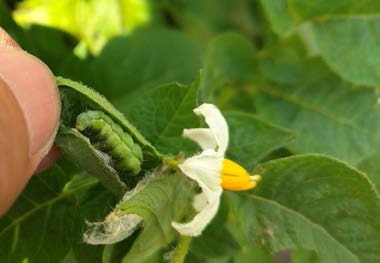
Kevilekho Usou & N Walling
Introduction: Thysanoplusia orichalcea, the slender burnished brass, commonly known as the soybean semilooper, is a moth of the family Noctuidae. The species was first described by Johan Christian Fabricius in 1775. It is a polyphagous pest of vegetable crops that originated in Indonesia, from where it spread to Europe, South Asia, India, Sri Lanka, Africa, Australia and New Zealand.
Host Plants: The larvae is polyphagous and feed on various herbaceous plants, including crops such as sunflower, potato Cabbage, cauliflower, and soybean, with soybean as a primary host.
Life cycle:
Oviposition
After copulation, the female lays eggs on the lower surface of leaves. The moth lays single egg at a time but sometimes eggs were laid in cluster. Egg is shiny, round, creamish with greenish tinge. Egg is 0.5- 0.7mm in length and 0.4- 0.5mm in width.
Incubation
Incubation leads to the hatching of a small worm like larva from egg, representing 1st instar stage. Incubation duration was recorded between 3.5 – 5.0 days. As the egg proceeds for hatching, change in the colour of egg was observed from shiny creamish to dusty brown.
Larval stage
The larvae of Thysanoplusia orichalcea represents the damaging phase and affects the development of crop plant. Newly hatched larvae feed by scrapping upon the epidermis of leaf thereby, making translucent feeding windows on leaves. The maturing larvae show voracious attack and engulf the leaves including their vein and midrib part. It takes 15- 20 days to complete larval phase.
Pre pupa
After voracious feeding, mature 5th instar contracts its body, appendages and stops feeding. This marks the prepupal behaviour of the moth. It is a shorter phase and remains for about 1-1.2 days.
Pupa
Early pupa is light creamish in colour which turns into dark brown towards maturity. Pupal period is observed between 14- 15.5 days.
Adult
Adult punctures an escape hole and comes out of pupal chamber. Adult is a noctuid moth with smooth, filliform antennae and a characteristic golden patched forewing. Abdomen is flurry and covered with velvet like hairs. Hind wing is grayish brown with darker margins. Total life cycle takes about 34.5- 43.7 days.
Nature of Damage: Adult moth visit crop plant and lays eggs on the lower side of leaves. Larval stage exhibits the destructive phase. Freshly emerged larvae show scrapping of epidermal part of leaves while the maturing larvae feed voraciously on entire leaves even veins and midribs of leaf. This behaviour of larvae interferes with the photosynthetic activity of plant and affects growth of plant. Infestation results in the skeletonization of the leaves, thereby, affecting badly the yield of the crop.
Management:
1. Cultural Control: Light Traps: the pest is a noctuid, which means it is very active at night. Placing light traps at strategic traps in the field will greatly manage the adult population.
2. Biological Control: Application of Bacillus thurengiensis and Beauvaria bassiana followed by spraying of neem oil after 2 weeks can reduce the pest population to a large extent but in cases of economic threshold levels of the pest population, chemical control is recommended.
Economic Threshold Level: 7-15 larvae per plant.
3. Chemical Control:
• Emamectin Benzoate: This pesticide was first manufactured in 2008 and is broad spectrum and highly effective. In addition, it has very low residual effects and generally considered safe.
• Spinosad: Spinosad is a natural substance made by a soil bacterium that is toxic to insects. It is a mixture of two chemicals called spinosyn A and spinosyn D. It is used to control a wide variety of pests.
These include thrips, leafminers, spider mites, mosquitoes, ants, fruit flies and others. It is considered an organic pesticide.
• Deltamethrin: Deltamethrin belongs to a group of pesticides called synthetic pyrethroids. This pesticide is toxic to aquatic life, particularly fish, and therefore must be used with extreme caution around water. Although generally considered safe to use around humans, it is still neurotoxic to humans.
• Fenvalerate: Fenvalerate is one of the most versatile synthetic pyrethroid insecticides. It is mostly used in agriculture and on cattle, but also in homes and gardens. It acts as a stomach poison against a wide variety of leaf and fruit-eating insects. This pesticide is toxic to humans.
Dosage: 1-2ml/ litre of water or as recommended in label.
• Precautions: Although the above given pesticides are considered generally safe for use, utmost care should be take while handling pesticides of any kind. Do not let it come in direct contact with skin and always store the containers away from children and animals. Also, cover your mouth and nose with mask and hands with gloves while spraying and handling any kind of pesticides.





